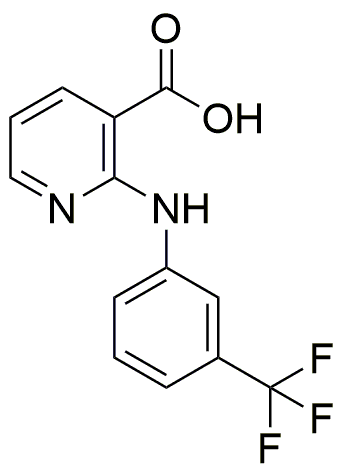Niflumic acid is widely utilized in research focused on:
- Pain Management: This compound is primarily used as a non-steroidal anti-inflammatory drug (NSAID) to alleviate pain and inflammation, making it valuable in clinical settings for treating conditions like arthritis.
- Pharmaceutical Development: Researchers explore its efficacy and safety profiles in drug formulation, leading to the development of new medications that target pain relief with fewer side effects compared to traditional NSAIDs.
- Veterinary Medicine: Niflumic acid is also applied in veterinary practices to manage pain and inflammation in animals, providing an effective treatment option for various conditions.
- Research on Inflammatory Diseases: Scientists utilize this compound in laboratory studies to better understand the mechanisms of inflammatory diseases, contributing to the development of innovative therapies.
- Comparative Studies: Its unique properties allow researchers to conduct comparative studies with other NSAIDs, helping to identify potential advantages in terms of efficacy and safety, which can guide clinical decisions.
General Information
Properties
Safety and Regulations
Applications
Niflumic acid is widely utilized in research focused on:
- Pain Management: This compound is primarily used as a non-steroidal anti-inflammatory drug (NSAID) to alleviate pain and inflammation, making it valuable in clinical settings for treating conditions like arthritis.
- Pharmaceutical Development: Researchers explore its efficacy and safety profiles in drug formulation, leading to the development of new medications that target pain relief with fewer side effects compared to traditional NSAIDs.
- Veterinary Medicine: Niflumic acid is also applied in veterinary practices to manage pain and inflammation in animals, providing an effective treatment option for various conditions.
- Research on Inflammatory Diseases: Scientists utilize this compound in laboratory studies to better understand the mechanisms of inflammatory diseases, contributing to the development of innovative therapies.
- Comparative Studies: Its unique properties allow researchers to conduct comparative studies with other NSAIDs, helping to identify potential advantages in terms of efficacy and safety, which can guide clinical decisions.
Documents
Safety Data Sheets (SDS)
The SDS provides comprehensive safety information on handling, storage, and disposal of the product.
Product Specification (PS)
The PS provides a comprehensive breakdown of the product’s properties, including chemical composition, physical state, purity, and storage requirements. It also details acceptable quality ranges and the product's intended applications.
Certificates of Analysis (COA)
Search for Certificates of Analysis (COA) by entering the products Lot Number. Lot and Batch Numbers can be found on a product’s label following the words ‘Lot’ or ‘Batch’.
*Catalog Number
*Lot Number
Certificates Of Origin (COO)
This COO confirms the country where the product was manufactured, and also details the materials and components used in it and whether it is derived from natural, synthetic, or other specific sources. This certificate may be required for customs, trade, and regulatory compliance.
*Catalog Number
*Lot Number
Safety Data Sheets (SDS)
The SDS provides comprehensive safety information on handling, storage, and disposal of the product.
DownloadProduct Specification (PS)
The PS provides a comprehensive breakdown of the product’s properties, including chemical composition, physical state, purity, and storage requirements. It also details acceptable quality ranges and the product's intended applications.
DownloadCertificates of Analysis (COA)
Search for Certificates of Analysis (COA) by entering the products Lot Number. Lot and Batch Numbers can be found on a product’s label following the words ‘Lot’ or ‘Batch’.
*Catalog Number
*Lot Number
Certificates Of Origin (COO)
This COO confirms the country where the product was manufactured, and also details the materials and components used in it and whether it is derived from natural, synthetic, or other specific sources. This certificate may be required for customs, trade, and regulatory compliance.


